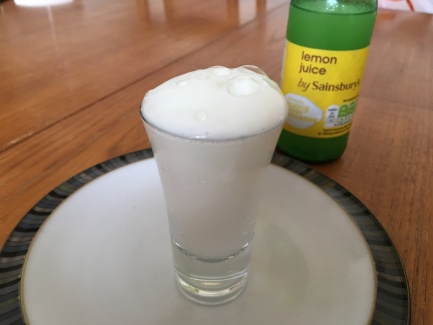Gosh, it’s been a while. Sorry about that. So much to do, so little time. To tide you over, here is a Friday Chemistry Fix – this was originally written for the WI Moodle.

What’s involved?
Neutralising acidic household substances with bicarbonate of soda, and using the bubbles of carbon dioxide that are formed to make a lava-like foam erupt from the container.
You will need:
- Water
- Sodium bicarbonate
- Washing-up liquid
- Shot glasses
- Something to stir the shot glass with, such as the handle of a teaspoon
- Household products to experiment with, such as:
- Vinegar
- Cola
- Lemon juice
- Other citrus fruit juices
- Milk
- Buttermilk
- Yoghurt
You only need a small amount of each product to test, a few drops or a teaspoon’s worth.
You should think about:
Safety: You will only use things you are likely to find around the house already or can buy without restrictions, but here are a few tips to help avoid any problems.
If you mix an acidic household substance like lemon juice or vinegar with bicarbonate of soda at any point, be prepared for the mixture to bubble up and escape its container – that’s the effect you’re trying to achieve, but if you use large quantities it can be a bit messy. If you’ve added cabbage indicator to the mix, you might stain your work surface, depending on what it’s made from.
Many household products have safety information on the packaging. Please take note of this information before you use a product in this experiment. You may want to wear gloves, eye protection and an apron.
Workspace and activity: Best to work on a metal, glass, plastic or granite surface and perhaps don an apron. Keep away from unvarnished wood and carpets, too! The kitchen or utility room is your best bet for this experiment. Keep an old cloth or kitchen roll to hand to wipe up any spillages.
Procedure:
Step 1: Mix half a teaspoon (about 3 ml) of bicarbonate of soda and one teaspoon of water in a shot glass. 
Step 2: Add a drop of washing-up liquid and stir the mixture well.

Step 3: Add a teaspoon of your chosen household acid, and then stir again. Look out for the foam!

If you’re feeling scientific, make a note of how much foam is produced.
Step 4: Repeat steps 1-4 for as many household substances as you like.

You can alter the order of addition: it works just as well to mix the water and acid, then washing-up liquid, and finally bicarbonate of soda. For a bit of fun, try adding food colouring.
Step 5: Wash the solutions down the sink and clean up.
Brief explanation
It won’t have escaped your attention that mixing bicarbonate of soda and acids such as lemon juice causes bubbles to form. The washing-up liquid simply traps the bubbles and keeps them in a foam for a few minutes. You can repeat the process without washing-up liquid to see what difference it makes.
What’s happening here? Bicarbonate of soda is a base, and it can neutralise acids, but most neutralisation reactions do not generate gas (i.e. bubbles). So why do these bubbles form when we neutralise with bicarbonate of soda? The answer lies in the chemical formula of bicarbonate of soda: NaHCO3.
Bicarbonate of soda, known to scientists as sodium bicarbonate, is an ionic compound that consists of equal numbers of sodium ions (Na+) and bicarbonate ions (HCO3−). The bicarbonate ion is the active part of the compound during a neutralisation reaction. It quenches acids by removing a hydrogen ion (H+) from them. The initial result is that bicarbonate (HCO3−) is converted to carbonic acid (H2CO3), but carbonic acid is unstable in most conditions and tends to decompose to water (H2O) and carbon dioxide (CO2). It’s the CO2 that makes up the gas in the bubbles.
The individual steps can be shown as chemical equations, where “HA” represents any acid:
Transfer of a hydrogen ion from the acid to bicarbonate: HA + HCO3− → A− + H2CO3
Decomposition of carbonic acid into carbon dioxide and water: H2CO3 → H2O + CO2
The overall reaction for an acid HA can be described as follows:
HA + NaHCO3 → NaA + H2O + CO2
Sodium ions (Na+) and the remainder of the acid molecules after H+ is removed (A−) are left in solution after the reaction. They’re shown above as NaA, but you would only be able to isolate that as a pure compound if you removed all the water and washing-up liquid that’s also in the shot glass. These are the kinds of problems that keep chemists busy all day.
Acids of different strengths will cause this neutralisation reaction to go at different speeds, and the amounts of acid, bicarb, water and washing-up liquid you add also have an influence. Plenty to experiment with!
Contributors: Ben Mills, Natalie Fey

